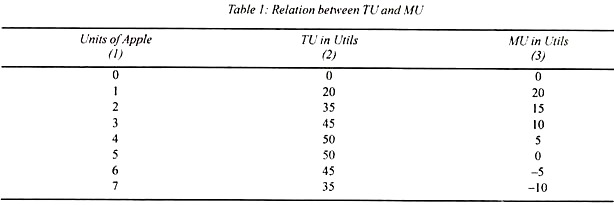In this article we will discuss about the relationship between Total Utility and Marginal Utility.
Every commodity possesses utility for the consumer. When the consumer buys apples he receives them in units, 1, 2, 3, 4 etc., as shown in table 1. To begin with, 2 apples have more utility than 1; 3 more utility than 2, and 4 more than 3. The units of apples which the consumer chooses are in a descending order of their utilities.
In his estimation, the first apple is the best out of the lot available to him and thus gives him the highest satisfaction, measured as 20 utils. The second apple will naturally be the second best with lesser amount of utility than the first, and has 15 utils. The third apple has 10 utils and the fourth 5 utils.
Total utility is the sum total of utilities obtained by the consumer from different units of a commodity. In our illustration, the total utility of two apples is 35 = (20 + 15) utils, of three apples 45 = (20 + 15 + 10) utils, and of four apples 50=(20+15+10+5) utils.
ADVERTISEMENTS:
Marginal utility is the addition made to total utility by having an additional unit of the commodity. The total utility of the two apples is 35 utils. When the consumer consumes the third apple, the total utility becomes 45 utils. Thus, marginal utility of the third apple is 10 utils (45—35).
In other words, marginal utility of a commodity is the loss in utility if one unit less is consumed. Algebraically, the marginal utility (MU) of N units of a commodity is the total utility (TU) of N units minus the total utility of N-1. Thus MUN = TUN —TUN.
The relation between total and marginal utility is explained with the help of Table 1.

This relationship is shown in Figure 1. To draw the curves of total utility and marginal utility, we take total utility from column (2) of Table 1. and obtain rectangles. By connecting the tops of these rectangles with a smooth line, we get the TU curve that peaks at point Q and then slowly declines. To draw the MU curve, we take marginal utility from column (3) of the table.
ADVERTISEMENTS:
The MU curve is represented by the increment in total utility shown as the shaded block for each unit in the figure. When the tops of these blocks are joined by a smooth line, we obtain the MU curve. So long as the TU curve is rising, the MU curve is falling. When the former reaches the highest point Q1 the latter touches the X-axis at point С where the MU is zero. When the TU curve starts falling from Q onwards, the MU becomes negative from С onwards.